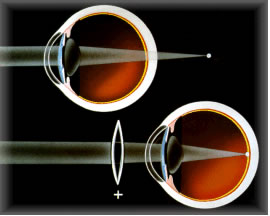HYPEROPIA (FAR-SIGHTED)

Hyperopia (far-sighted) means distance vision is clearer than close vision.
- The eye is shorter or less curved than normal causing light to focus behind the back of the eye (retina).
- There is a genetic tendency for hyperopia.
- Moderate to severe involvement is often present from birth, thus children should have an eye examination between 1-3 years.
- There is a high risk of developing a permanent lazy eye if undetected.
- IT CAN BE EASILY MISSED DURING A SCHOOL VISION SCREENING.
- Farsightedness is usually NOT progressive and can sometimes diminish during adolescence.
- It is NOT considered an eye disease. A hyperopic eye is a healthy eye which focuses light slightly off target.
- Farsightedness is corrected with glasses, contact lenses, or refractive surgery.
SYMPTOMS
- Difficulty focusing on objects closer than 2 feet
- Tired eyes, headache, or eyestrain after reading or computer work
- Red or watering eyes especially when performing close tasks
- One turned-in eye, especially in infants and children
- Poor reading and/or school skills
- Reluctance to do homework or close vision tasks
Hyperopia and Children
- Infancy:
Hyperopia is often present at birth and should be addressed within the first year or two of life. If the hyperopia is of a high magnitude, failure to correct for this vision condition could result in poor eye development. This can lead to a crossed and/or lazy eye.
- School age:
Hyperopia can only be diagnosed through a comprehensive eye/health examination. Hyperopia often goes undetected, and its symptoms are very subtle to nonexistent. Even though small amounts of farsightedness can be normal, it can adversely affect a child’s school performance. Sometimes the only difference between a struggling and a confident student is a pair of reading glasses.
How is hyperopia treated?
- GLASSES:
As with other refractive errors, corrective lenses are prescribed to help focus light more effectively on the retina. Depending on the degree of hyperopia, glasses may be needed all of the time for clear vision. If the degree of impairment is slight, glasses may be needed only for reading and computer vision.
Some times bifocals are given to children to help them better function in school so they don’t have to keep taking their glasses on and off when looking at the blackboard.
- CONTACT LENSES
- REFRACTIVE SURGERY: Not as common.
